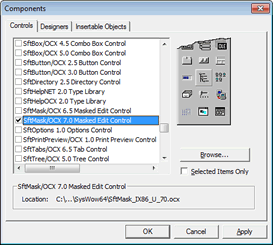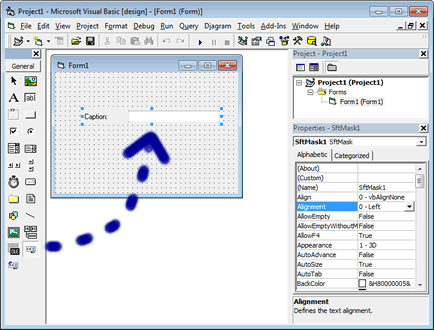Using SftMask/OCX with Visual Basic 6
Adding SftMask/OCX To A Project
Special Considerations
- Color Properties
Adding SftMask/OCX To A Project
The SftMask/OCX control must be added to the Toolbox before it can be used in a project. The Toolbox normally displays the standard Visual Basic controls and any other ActiveX controls that have been added previously.

The control is added to the Toolbox using the Project, Components... menu command, which displays the following dialog:

Select the control "SftMask/OCX 7.0 Masked Edit Control" by placing a check mark next to it and click OK.
This adds the control to the Toolbox. If you don't see the control in the list, make sure Selected Items Only is not checked. Once you click Apply or OK and an error message is displayed, the product SftMask/OCX is not correctly installed or the control may have been unregistered accidentally. Quit Visual Basic and use the entry Maintenance, Register SftMask OCX in Windows Registry in the SftMask/OCX 7.0 program group to register the control. Restart Visual Basic and try to add the control to the Toolbox again.
This adds two SftMask/OCX controls to the Toolbox, one for most development tools and one for Internet Explorer. You could use either with Visual Basic. It is recommended to use the regular control.
 for use with Visual Basic (and other development tools)
for use with Visual Basic (and other development tools) for use with Internet Explorer, VBScript only (do not use with Visual Basic)
for use with Internet Explorer, VBScript only (do not use with Visual Basic)
Now the control can be added to a form by clicking on the SftMask button of the Toolbox.

All required steps have now been completed to use SftMask/OCX.
Add the following sample code to initialize the control:
Private Sub Form_Load()
With SftMask1.Direct
.Mask = "$D $T"
.EditStyle = editSftMaskCalendarDropDown
.Contents.DateTime = #12/31/2014 9:00:00 AM#
.TabAdvance = True
.AutoAdvance = True
End With
End Sub In this example, the control is initialized at run-time using code. Of course it is also possible (and much easier) to set up all properties using the property pages. You can access the property pages by right-clicking on the control and select the Properties... entry of the popup menu.
You can run the sample application and it displays an edit control allowing entry of a date and time value with a popup calendar.
This sample displays an edit control for numeric input with popup calculator:
Private Sub Form_Load()
With SftMask1.Direct
.Mask = "!1$C,8.2!!"
.Alignment = alignSftMaskRight
.Contents.Value(1) = 88.12
End With
End Sub After adding the control to the form, right click on the control and select the Properties... entry of the popup menu. This displays the Property Dialog for the control.
Please note that you can right-click on a property. This displays a popup menu which can be used to access help information for the property or Property Dialog. Or double-click on the description of a property to access its help information.
This control has many properties and methods which you can use. This is a very simple example and doesn't even begin to exploit the capabilities of this control. Please take a moment to familiarize yourself with the objects offered by the SftMask/OCX control. Each object represents a specific area of the control and can be fully customized. Also make sure to run the demo which is included with this product and take a look at the included samples.
Special Considerations
Color Properties
The valid range for a color value is 0 to 16,777,215 (&HFFFFFF). The high order byte of a number in this range equals 0; the lower 3 bytes, from least to most significant byte, determine the amount of red, green, and blue, respectively. The red, green, and blue components are each represented by a number between 0 and 255 (&HFF). If the high byte is not 0, the system colors as defined in Control Panel's settings are used. The Windows API GetSysColor defines all valid constants. Please see your development environment's documentation for applicable color constants.
SftMask1.BackColor = vbHighlight
SftMask1.Calculator.BackColor = vbRed
Dim c As Long
c = SftMask1.BackColor



 for use with Visual Basic (and other development tools)
for use with Visual Basic (and other development tools) for use with
for use with 